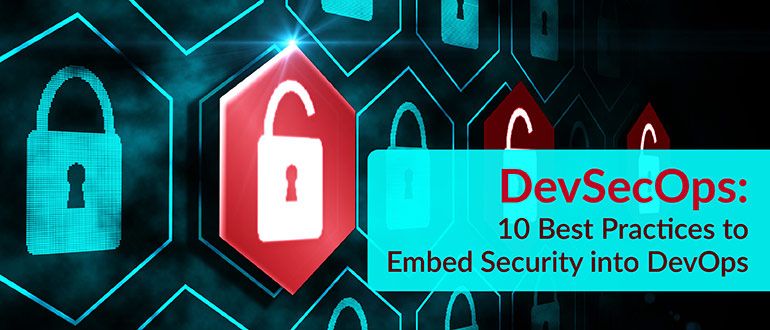DevSecOps: 10 Best Practices to Embed Security into DevOps

For companies that employ the agile approach, DevOps seems like a natural extension. Traditionally, enterprises started with integration, development and test automation early in the product lifecycle. Gradually, the agile delivery team took care of iterative development and monitoring practices that increase code quality.
Today, organizations work in unison to bridge the gap between development and operations (DevOps). They want to offer a faster market delivery with the least human interaction.
But what about security integrations? Is there a way to mitigate vulnerabilities early in the development lifecycle?
The answer is DevSecOps.
Exploring the Concept of DevSecOps
DevSecOps is short for development, security and operations. It brings together people, processes and technology to pursue a shared objective.
The objective of DevSecOps is to implement security decisions on the same scale as development and operations and make everyone in the product lifecycle accountable for security.
Why Should You Adopt DevSecOps?
People adopt DevSecOps because they are seeking:
- Modern alternative to traditional security engagement.
- Transparent collaboration and workflows during development.
- Security that’s built into the product, not applied at the final stage.
- Reduced expenses and faster delivery rate.
- Faster recovery speed in case a threat is detected.
Steps to a Typical DevSecOps Workflow
- A developer starts by writing code within a version control system.
- Any required change is committed to the version control system.
- Another developer analyzes the code to identify any security defect that may weaken code quality.
- An environment is created to deploy and apply security configurations to the system.
- Next, a test automation suite is executed to evaluate the newly deployed application.
- After it passes the automation test, the application is deployed to a production environment.
- This new production environment is actively monitored for security threats.
While there is no right way to transform organizational culture, below are a few components necessary to sustain a DevSecOps environment:
Let Developers Get Security Right: Developers are responsible for security. Therefore, you must keep them on top of cybersecurity best practices through continuous training and learning activities.
Promote an Open Culture: Openness in communication within the enterprise environment can drastically improve development and security. One way to keep information transparent is by using metrics and dashboards wherever possible.
Get Experts on Board: It is extremely difficult to transition from DevOps to DevSecOps without the supervision of expert security professionals. Hire people who understand security within the development and operations environment and let them train your DevSecOps team for the big transition.
Tempted to embed security into DevOps? How do you ensure that the best practices are followed? We have answers.
The Best Way to Implement the DevSecOps Process
Gather a single group of professionals (admins, developers, security engineers and testers) that are aware of your product from start to end. They should know your requirements and should be experts in deploying, monitoring and implementing new changes.
Once you have your team ready, here’s what you need to do next.
Plan
Planning is crucial. Do not just stick to feature descriptions. Instead, go for detailed user stories that include:
- Functional and nonfunctional requirements (e.g., security and performance).
- UI and UX designs.
- Acceptance test criteria.
- Threat models.
Develop
Start by evaluating your existing practices. Choose the best resources to build a development model in coherence with security guidelines.
Build
Automated build tools can do a lot more than compile codes. Use them to conduct test-driven development, enforce quality standards and ensure that the best security practices are implemented through static code analysis.
Test
When it comes to a DevSecOps environment, test automation is not limited to UI-focused Selenium tests. Optimally, your security practice should include the following:
- Unit testing.
- Front-end testing.
- Back-end testing.
- API testing.
- Database testing.
- Passive security testing.
Secure
Because development, operations and security go hand in hand, only a few issues are left unattended toward the end of the development process.
When vulnerabilities are identified, there is a better chance of determining if they are potential exploitations or false positives.
Deploy
Automated provisioning and deployments can be utilized to accelerate product delivery and add consistency in the development process. Using an infrastructure-as-code tool, one can audit properties across the IT infrastructure and enforce secure configurations in a system.
Operate
Routine maintenance and upgrades should be an indispensable component of your operations team. Leverage infrastructure-as-code tools to patch zero-day vulnerabilities and apply updates to the entire organization’s infrastructure.
Monitor
A continuous monitoring plan should be in action to generate real-time stats of how your system is performing. In case any exploitation is recorded, it can be addressed immediately.
Scale
Traditional data-center operations cannot entirely replace a compromised environment. Today’s ability to scale infrastructure through virtualization and the cloud, while addressing the demands of modern-day IT user base, should go a long way.
Adapt
When it is about sustaining an agile practice, continuous improvement is key. This is also true for DevSecOps practices, as you improve and adapt throughout the software development lifecycle.
Conclusion
DevOps isn’t going anywhere, anytime soon. It is the new phase of developing, releasing, and updating products in a software lifecycle.
That’s why high time security professionals let go of the traditional security stack and embrace security solutions at the speed of DevOps.
Originally published at DevOps



